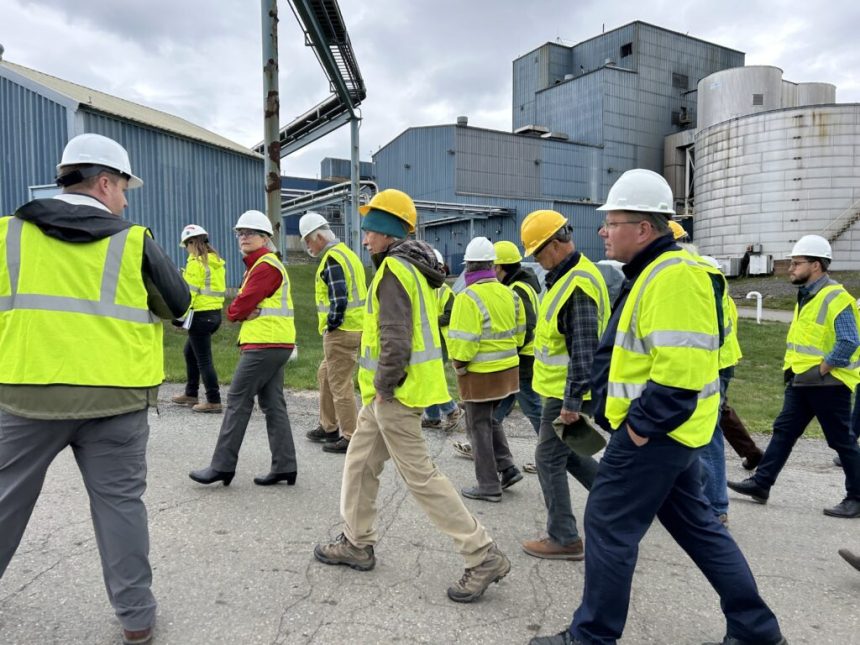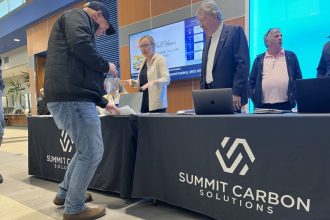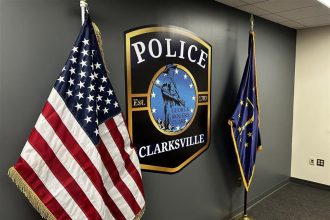Maine legislators, advocates and curious residents tour the Eagle Point Energy Center in Orrington, a waste-to-energy facility that can use solid waste to generate up to 25 megawatts of electricity. (Photo by AnnMarie Hilton/ Maine Morning Star)
A group of lawmakers, lobbyists, advocates and interested members of the public made a pilgrimage to three of Maine’s waste facilities Wednesday to see for themselves how the state is handling the roughly 1.8 million tons of waste generated each year.
Maine Sen. Denise Tepler (D-Sagadahoc) said the tour was intended to give members of the Legislature’s Environment and Natural Resources Committee, which she co-chairs, a chance to better understand the facilities that their work helps govern. Waste is a pressing environmental issue in the state right now, evidenced by the upwards of 40 people that joined the tours.
The day started at Municipal WasteHub in Hampden, a recycling facility that is in the process of installing an anaerobic digester to process organic waste, such as animal manure, food waste and sewage sludge. The next stop was Eagle Point Energy Center in Orrington, which is a waste-to-energy facility that can use solid waste to generate up to 25 megawatts of electricity. Since it came under new ownership last year, Eagle Point is still in the process of bringing operations back to full capacity.
Lawmakers tour Municipal WasteHub in Hampden, a recycling facility that is in the process of installing an anaerobic digester to process organic waste, on Oct. 15, 2025. (Photo by AnnMarie Hilton/ Maine Morning Star)
With sweeping views of surrounding Penobscot County and even Mount Katahdin to the north, the tour climbed to the very top of the state-owned Juniper Ridge Landfill in Old Town for its final stop. A steady stream of trucks came into Cell 16, a plot of land where trash is actively being landfilled, while excavators and bulldozers prepared adjacent land to be the next active cell.
Just over half of Maine’s landfill waste ends up in Juniper Ridge, which is expected to reach capacity in 2028. The state has signaled its support for expanding the facility despite objections from environmental advocates, the local community and the Penobscot Nation.
Rep. Dan Ankeles (D-Brunswick), a committee member, said the tours helped paint a better picture of waste processes in the state. He pointed out that all three facilities have plans to expand their capacity, but said the information he learned Wednesday showed that Maine’s trash challenges are about more than just filling up a landfill.
“It’s not just about landfill capacity,” Ankeles said. “There’s a lot going on at once and this is a jigsaw puzzle with a lot of pieces and some of the pieces are changing shape.”
In particular, Ankeles, who sponsored a suite of legislation earlier this year in response to a spill of toxic forever chemicals in his community, was left thinking about the downstream effects of the water that goes from these waste facilities into wastewater treatment plants.
At Juniper Ridge, employees explained how the leachate, or the water that seeps through the waste and can pick up contaminants along the way, is transported to wastewater treatment plants that ultimately discharge it back into waterways.

Trucks bring waste to Cell 16 at Juniper Ridge Landfill, a plot of land where trash is actively being landfilled. Just over half of Maine’s landfill waste ends up in Juniper Ridge, which is expected to reach capacity in 2028. (Photo by AnnMarie Hilton/ Maine Morning Star)
Sewage sludge, which is known to be contaminated with per-and polyfluoroalkyl substances, otherwise known as PFAS, is mixed with the trash at Juniper Ridge — a process that Wednesday’s tour group was able to see up close when a bulldozer mixed a full dump-truck load of sludge into truckloads of trash.
In addition to the challenges surrounding solid waste capacity, Ankeles said Maine’s current waste processes leave the state “in freefall when it comes to letting PFAS go into our water bodies.”
PFAS have been tied to myriad health concerns, including elevated incidences of certain cancers and other illnesses.
Environmental groups, local residents and the Penobscot Nation, whose reservation sits downstream from the landfill, have raised concerns about insufficient treatment of leachate as the state considers allowing the landfill to expand operations to the north. The Maine Department of Environmental Protection has required the landfill operator, Casella, to install an approved system for treating landfill leachate for PFAS before it could expand operations.
The tour included a look at where Casella plans to install that system.
At the close of the tour, Ankeles said he was thinking about what his committee could do to address these challenges. While bills for the upcoming legislative session in January aren’t finalized yet, Tepler put in a request that seeks to install a sludge dryer at Juniper Ridge, which would decrease sludge volume and weight.
During the tour, a Casella employee said reducing wet waste could help decrease the need for additional bulky waste to be brought in to stabilize the trash mixture. However, there were questions raised about whether sludge could rehydrate.
That issue became a flashpoint last session due to a proposal — that was eventually signed into law — to allow even more out-of-state waste to be brought to Maine.
During the debate on the bill, Tepler said she’s “not convinced the operator of the landfill is an honest broker,” but warned that without the ability to bring in more bulky waste to stabilize the sludge it could mean “serious problems at the landfill.”









